Edible / biodegradable packaging for food
- Like
- Digg
- Del
- Tumblr
- VKontakte
- Buffer
- Love This
- Odnoklassniki
- Meneame
- Blogger
- Amazon
- Yahoo Mail
- Gmail
- AOL
- Newsvine
- HackerNews
- Evernote
- MySpace
- Mail.ru
- Viadeo
- Line
- Comments
- Yummly
- SMS
- Viber
- Telegram
- Subscribe
- Skype
- Facebook Messenger
- Kakao
- LiveJournal
- Yammer
- Edgar
- Fintel
- Mix
- Instapaper
- Copy Link
Posted: 1 May 2018 | Dr Lizhe Wang, Biomaterial Scientist and Dr Joe P. Kerry, Head of the Food Packaging Group, Department of Food and Nutritional Sciences, University College Cork | 8 comments
As traditional food packaging materials show shortcomings in terms of their environmental pollution impact and in their manufacturing requirements for non-renewable resources, the need for alternative packaging materials and packaging formats is now required more than ever.
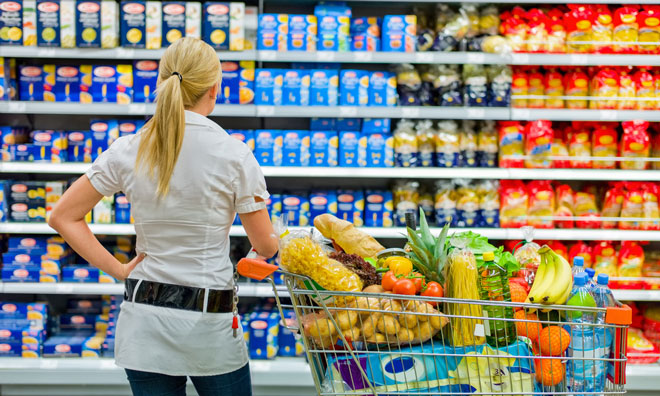

A major group of alternative and novel materials which possess future commercial potential are those derived from utilised and under-utilised food ingredients, or food grade ingredients. Consequently, they provide packaging materials which are not just biodegradable in nature, but which are edible also, thereby presenting greater opportunities for commercial application in a more sustainable manner. Therefore, the potential advantages that such packaging materials have over more current conventional packaging forms used by the food industry are obvious.
Consumers demand eco-friendly packaging solutions
To date, the majority of food packaging materials and formats consist primarily of laminates which can be comprised of plastics, metals and/or paper and glass. These materials are, and have traditionally been, manufactured and engineered for specific food packaging applications. However, consumer demands are changing with respect to food product purchasing and consumers are becoming increasingly aware of the presence, role and implications of the food packaging that surrounds their retail food purchases.
Issues pertaining to sustainability, environment, ethics, food safety, food quality and product cost are all becoming increasingly important factors for modern-day consumers when purchasing food products and a number of these issues are also enforced by food packaging legislative regulations. Changes in consumer packaging demands are being informed by continual drip feeding of negative information pertaining to conventionally-used packaging. For example, reports1 claim that plastics formed 38 per cent of all food packaging materials used in the US last year and that most of this would end up in landfill or cause an environmental risk when processed in incinerators. The author also went on to say that only small amounts of the 38 per cent of plastic waste would go on to be recycled.
Additionally, most of the packaging used today is synthetic in nature and has been derived from fossil fuels (from naphtha or natural gas) for over half a century. Commercial usage of such forms of packaging for a whole host of goods from food and pharmaceutical products through to electronic and fragile items have relied on a plentiful supply of cheap packaging materials. However, there are now global concerns about the depletion of non-renewable raw materials for manufacturing plastics. The global economy is quickly facing the scenario that greater oil demands are being faced with falling supplies.
The need for sustainability in food packaging
It is estimated that at some point between today and 2030, oil extraction will have peaked and oil fuel for transportation will have become increasingly uneconomic2. The world’s annual consumption of plastic materials has increased from approximately five million tonnes in the 1950s to nearly 230 million tonnes today. The total production of plastics in Europe was approximately 57.5 million tonnes in 2005, representing 25 per cent of the total worldwide production of 230 million tonnes, at similar levels to that of North America, at 24 per cent. The total demand of plastics in Europe was 47.5 million tonnes in 2005, of which 17.6 million tonnes (37 per cent) were used for manufacturing packaging materials. Since 37 per cent of plastics are used for packaging, it is not surprising that this category has attracted most attention from policy-makers and environmentalists3. Food packaging is a significant part of that total and thus even a small reduction in the amount of materials used for each package would result in a significant cost reduction and may improve solid waste disposal4. The current trend in new food packaging development is that, wherever possible, it should not only be natural and ‘environmentally friendly’, but also functional and cost-effective.
Thus, development of edible/biodegradable films/coatings for effective food packaging has generated considerable interest in recent years due to their potential to reduce and/or replace conventional, non-biodegradable plastics. As food manufacturers require packaging materials to be food grade, maintain/enhance product shelf-life stability and safety and utilise nominal values of packaging, the reduction or replacement with alternative biodegradable forms would clearly allow improvement in overall operating costs while reducing waste streams. EU regulatory pressures, coupled with indirect demands via consumer groups on EU food processors and packaging manufacturers, to develop/utilise ‘environmentally friendly’ packaging systems are increasing. Research development in the area of edible/biodegradable films/coatings is a key and unique field of exploration within food packaging which possesses enormous commercial and environmental potential.
Edible/biodegradable packaging research
Scientific research on the production, quality and potential applications of edible/biodegradable films in food manufacturing has been carried out by several research groups worldwide and has been reported in research publications5-9. The enormous commercial and environmental potential in the area of edible/biodegradable films/coatings has often been stressed5,10,11 and numerous publications have primarily addressed issues relating to mechanical properties, gas migration, and the effects of other factors on these properties, such as type and content of plasticisers, pH, relative humidity and temperature etc.6,8,10-15.
However, research into edible/biodegradable films is still in its infancy and research on industrial application of edible/biodegradable films has received more attention in recent years, however, coverage is still quite limited.
Researchers in the Food Packaging Group, Department of Food and Nutritional Sciences, University College Cork, Ireland, have developed several functional, biopolymer-based, edible/biodegradable films over the last few years.
Testing food-grade polymers
In our most recent study, more than 20 food ingredients were investigated for their film-forming abilities and a number of optimised food-grade polymers were produced over a range of concentrations and processing parameters in an attempt to evaluate their mechanical and permeability properties (tensile strength, puncture resistance, tear strength and oxygen/water vapour permeability)16-19. The properties of biopolymer films were found to be significantly affected by pH adjustment and corn oil addition and laminated films showed the most desirable properties among all the film formats evaluated. Laminate films consisting of sodium alginate emulsion, gelatine emulsion and whey protein isolate emulsion had the highest tensile strength, puncture strength and tear strength values (55.77 MPa, 41.36 N, 27.32 N, respectively); films formed from gelatine emulsion (pH = 10.54, CO = 27.25 per cent) had the highest elongation values (351.12 per cent); composite films formed from WPI, G and SA (WPI: G: SA = 10.0:16.0:14.0) had the lowest oxygen permeability values 8.00 (cm3·mm/m2·d·kPa); Bilayer films formed from gelatine emulsion and sodium alginate emulsion had the lowest water vapour permeability values (22.63 g·mm/kPa·d·m2).
Edible films formed from protein-polysaccharide powders (whey protein concentrate (WPC)-45, alginate, pectin, carrageenan, or konjac flour) were also investigated by our group at UCC. Results showed that films formed from co-dried powders had lower water vapour permeability, higher tensile strength, elastic modulus and elongation than equivalent films formed from the dry blended powders and there was potential to alter the physical properties of hydrophilic films by combining whey protein and polysaccharide components20. Previous work by our research group also involved the extrusion of pectin, pea starch and gelatine/sodium alginate blends for the preparation of sausage casings21,22.
The limitations of edible packaging
Generally, edible films have limited application primarily because of their inferior physical characteristics. For example, single, lipid-based films have good moisture barrier properties but contain no mechanical strength23. Consequently, laminated films were formed by adhering two or more biopolymer films together. However, laminated films are advantageous to single, emulsion-based biopolymer films due to their possession of enhanced barrier properties. The creation of laminated structures has the potential to overcome these shortcomings by engineering edible/biodegradable films with multiple functional layers.
Edible films and coatings based on water-soluble proteins are often water-soluble themselves but possess excellent oxygen, lipid and flavour barrier properties. Proteins act as a cohesive, structural matrix in multicomponent systems, yielding films and coatings with good mechanical properties. Lipids, on the other hand, act as good moisture barriers, but have poor gas, lipid and flavour barriers. By combining proteins and lipids in emulsion or bilayer (a membrane consisting of two molecular layers), the positive attributes of both can be combined and the negatives minimised.
From the research conducted by the Food Packaging Group at UCC, the general characteristics of developed edible/biodegradable films are as follows:
- Thickness of manufactured edible/biodegradable films range from 25μm to 140μm
- Films can be clear, transparent, and translucent or opaque depending on the ingredients used and the processing technique employed (Figure 1: a, b)
- Aging specific film types under controlled environmental conditions (Figure 2) improved mechanical properties and gas barrier properties
- Storing films at ambient condition (18-23°C, 40- 65 per cent RH) for five years did not significantly alter structural characteristics
- Films formed from various ingredients can be relatively easily laminated together (Figure 3)
- Manufactured films can be labeled, printed on or heat sealed
- Small variations in film microstructure (e.g. biopolymer phase separation) affects film properties (Figure 4)
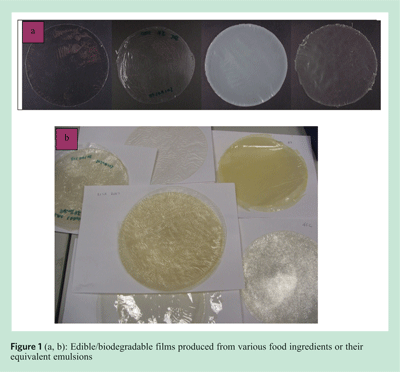

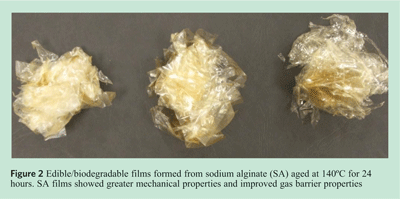

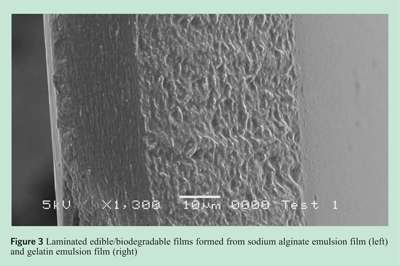

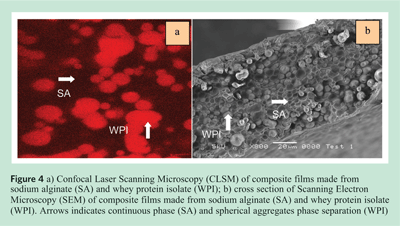
Edible/biodegradable films versus traditional synthetic film (Polyethylene terephthalate (PET)/Polystyrene (PS))
In comparison to synthetic film (Figure 5), edible/biodegradable films (4G) had the best elongation (351.12 per cent), followed by PET (136.94 per cent). PS showed the highest tensile strengths (77.17 MPa), followed by edible/biodegradable films SAOGOWPIO (55.77 MPa). However, puncture strength of edible/biodegradable films SAOGOWPIO was nearly seven times greater than either synthetic film used (6.34 N, 6.36 N for PET and PS, respectively). Although edible/biodegradable films showed an overall lower mechanical strength than synthetic films, they were still within a sufficiently acceptable range to be capable of holding most food products. One great advantage that edible/biodegradable films possess is that they generally have significant resistance to oxygen permeability (e.g. GWPISA-4, 8 cm3·mm/m2·d·kPa). Conversely, water vapour permeability of edible/biodegradable films is in general, higher than that of synthetic films, which is a major disadvantage but one which is being addressed.
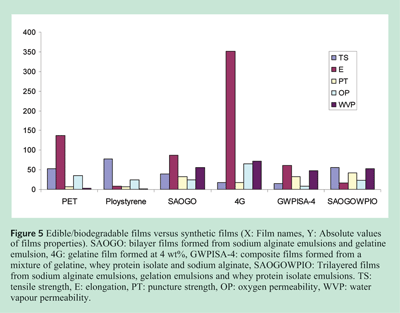

Application example of developed edible/biodegradable packaging on meat
Manufactured films were tested in food packaging/processing applications to assess their performance during food preparation and storage. Figure 6 shows one example of meat products prepared, wrapped and stored using edible film wrappings. From this one example, observed advantages in using such materials included:
- Increasing cooking yield by 12 per cent
- Decreasing moisture loss by seven per cent during storage (-18°C, 60 days).
- Improved product flavour and juiciness
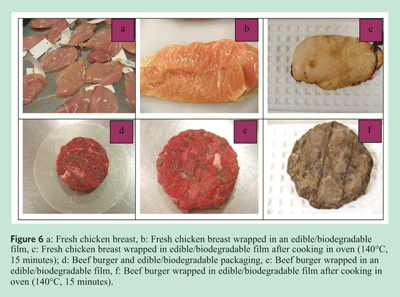

Future packaging
The production of edible/biodegradable films is mostly at research level and the commercial use of films is limited at present. Research is currently ongoing, however, it is expected that the use of edible/biodegradable packaging materials in foods has a bright future as edible/biodegradable packaging can offer a natural protection to foods according to specific packaging requirements. Despite the advantages of edible/biodegradable materials which have been presented by scientists, a number of obstacles in their development potential have to be overcome, such as cost effectiveness, improved water vapour permeability barrier and technological application methods. Full commercial production and application is still some way off, but the potential that edible/biodegradable films possess is now being realised.
Acknowledgement
The authors would like to acknowledge Dr. Mark A. E. Auty, Senior Research Scientist, Manager of the National Food Imaging Centre (NFIC), Teagasc Moorepark, Co. Cork for assistance in preparing and imaging edible/biodegradable film samples (SEM & CLSM) for this article.
References
- Hopkins (2009). Sustainable (“Green”) packaging market for food and beverage worldwide, 2nd edition. Shelley Carr, Maryland Rockville, Maryland, US.
- Hammond, R (2007). The World in 2030: Summary and Initial Industry Response. Plastics Europe, Brussels, Belgium.
- Azapagic A, Emsley A, Hamerton, I. (2003). Polymers: The Environment and Sustainable Development. John Wiley and Sons, Chichester, UK.
- Han, J.H. (2005). New technologies in food packaging: an overview. In: Han J.H. (Ed.), Innovations in Food Packaging. Elsevier Academic Press. London, 3-11.
- Cruz-Romero, M. and Kerry, J.P. (2008). Crop-based biodegradable packaging and its environmental applications. CAB Reviews: Perspectives in Agriculture, Veterinary Science, Nutrition and Natural Resources 3, No. 074, 1-25.
- Krochta, J. M. (1992). Control of mass transfer in foods with edible coatings and films. In: R. P. Singh, & M. A Wirakartakasumah (Eds), Advances in Food Engineering, Boca Raton, FL: CRC Press, pp. 517-538.
- Gontard, N. & Guilbert, S. (1994). Bio-packaging: Technology and properties of edible and /or biodegradable material of agricultural origin. In: M. Mthlouthi, (Eds), Food Packaging and Preservation. London: Blackie Academic and Professional, pp.159 – 181.
- Krochta, J.M. & de Mulder-Johnston, C. (1997). Edible and biodegradable polymer films: challenges and opportunities. Food Technology, 51(2), 61 – 74.
- Rivero, S., Garcia, M. A. & Pinotti, A. (2009). Composite and bi-layer films based on gelatine and chitosan. Journal of Food Engineering, 90 (4), 531-539.
- Kester, J. J. & Fennema, O. R. (1986). Edible Films and Coatings: A Review Food Technology, 40, (12) 47 – 59.
- Debeaufort, F., Quezada, G. A. & Voilley, A. (1998). Edible films and coatings: Tomorrow’s packagings: A review. Critical Reviews in Food Science and Nutrition, 38, 299-313.
- Krochta, J. M. (1997). Edible composite moisture-barrier films. In: B. Blakistone, (Eds), Packaging Yearbook, National Food Processors Association. Washing, DC: pp. 38 – 51.
- Cuq, B., Gontard, N. & Guilbert, S. (1994). Edible films and coatings as active layers, In: M. L. Rooney (Eds), Active Food Packaging, London: Blackie Academic and Professional, pp. 111-142.
- McHugh, T. H., Huxsoll, C. C. & Krochta, J. M. (1996). Permeability properties of fruit puree edible films. Journal of Food Science, 61, 88-91.
- Gennadios, A. (2002). Protein-based films and coatings. M. A., Boca Raton, FL: CRC Press. pp, 1-12.
- Wang, L.Z., Liu, L., Holmes, J., Kerry, F.J., & Kerry, J.P. (2007). Assessment of film-forming potential and properties of protein and polysaccharide-based biopolymer films. International Journal of Food Science and Technology, 42 (9), 1128-1138.
- Wang, L.Z., Liu, L., Holmes, J., Huang, J., Kerry, F.J., & Kerry, J.P. (2008). Effect of pH and addition of corn oil on the properties of whey protein isolate-based films using response surface methodology. International Journal of Food Science and Technology, 43 (5), 787-796.
- Wang, L.Z., Auty, Mark, A.E., & Kerry, J.P. (2009 a). Physical assessment of composite biodegradable films manufactured using whey protein isolate, gelatine and sodium alginate. Journal of Food Engineering, doi:10.1016/j.jfoodeng.2009.07.025 Available online 19 August 2009.
- Wang, L.Z., Auty, Mark, A.E., Rau, A., Kerry, J.F., & Kerry, J.P. (2009 b). Effect of pH and addition of corn oil on the properties of gelatine-based biopolymer films. Journal of Food Engineering, 90, 11-19.
- Coughlan, K, Shaw N. B., Kerry J. F. & Kerry J. P. (2004). Combined effects of proteins and polysaccharides on physical properties of whey protein concentrate-based edible films. Journal of Food Science, 69 (6), E271-E275.
- Liu, L., Kerry, J. F. & Kerry, J. P. (2005). Selection of optimum extrusion technology parameters in the manufacture of edible/biodegradable packaging films derived from food-based polymers. Journal of Food, Agriculture & Environment, 3 (3&4), 51-58.
- Liu, L., Kerry, J. F. & Kerry, J. P. (2006). Effect of food ingredients and selected lipids on the physical properties of extruded edible films/casings. International Journal of Food Science and Technology, 41, 295-302.
- Debeaufort, F., Quezada-Gallo, J. A., Delporte, B. & Voilley, A. (2000). Lipid hydrophobicity and physical state effects on the properties of bilayer edible films. Journal of Membrane Science, 180, 47-55.










Thanks for sharing the information about the biodegradable packaging for food. I think this information surely help to the food packaging companies.
How to contact the author of this article?
Hi there, the author’s of this article are Dr Lizhe Wang, Biomaterial Scientist and Dr Joe P. Kerry, Head of the Food Packaging Group, Department of Food and Nutritional Sciences, University College Cork. You could try Linked In or perhaps through the university itself?
This is a relevant article and the authors has given good idea of the alternative packaging materials. One option that has to be considered to develop biodegradable packaging using agricultural residues such as straws, husks, stalks etc. Although some attempts have been made to convert the residues into packaging, the residues are subject to chemical processing (pulping and bleaching) which makes the products difficult to be called environmentally friendly. There are possibilities of using the residues in their native to develop packaging boxes, cups and containers which I am also involved.
I’m interested in the topic of edible films, because of my dissertation on this subject, but use lactic acid bacteria.
where can i find the full scientific article of this? I am really interested, thanks. [email protected]
Hi Karina – contact the author at University College Cork – [email protected]
Consumers should demand these types of products, our oceans have enough plastic.